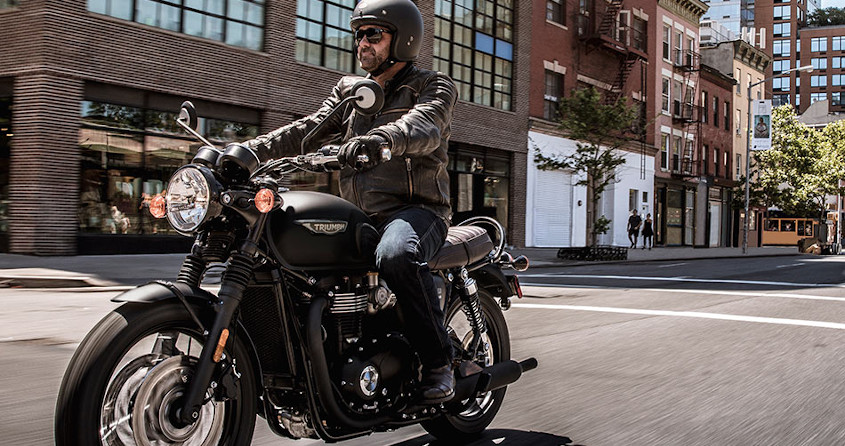Triumph Bonneville
Bike of the Week

Back in the 50s when you might've popped out sporting a DA hairdo with a greasy quiff in front, listening to Bobby Darin singing Mack The Knife on the radio, and watching The Wild One at the pictures, what would you have ridden? Well the cool motorcycle of choice at the time would probably have been a Triumph as ridden by the king of cool Marlon Brando in the film mentioned above. In the 1950s Triumph was riding high as the most popular motorcycle manufacturer in the business and was in the lead on the country's roads and at the races - top of the league in both sales and performance. Then in 1959 a new Triumph model hove into view, the Triumph Bonneville 650. Although it was a new machine to all intents and purposes it was actually really a descendent of the 500 Triumph Speed Twin which was invented in 1937 by Edward Turner and was the ancestor of many classic British motorcycles which were to follow. Triumphs were loved by the motorcycling public but they demanded more and more speed and power so the engineers and designers at Triumph brought out more and more improvements year on year to meet the demands. New and improved models came out one after the other in rapid succession. 1950 saw the 6T Thunderbird, 1953 the Tiger T110, 1956 the TR6 Trophy. Popular in the US, Triumphs were required to get more and more powerful to meet the demand for speed. Triumphs triumphed at Bonneville Salt Flats and Turner proudly added 'The World's Fastest Motorcycle' to the manufacturer's pedigree.
Birth Of The Bonnie
By 1959 a new, even cooler and faster machine was expected off the production line so Triumph delivered in spades with the all new Triumph Bonneville 650, named after the Bonneville Salt Flats, a place synonymous with speed, since the 1930s. The Bonneville was given the moniker T120 to imply that that was its top speed and at the time it really ran everything else off the road for sheer speed and performance.
The only problem with the original design was that, despite its great engine, it was not a stripped down streamlined racy looking bike – instead it had fully valanced mud guards and a nacelled headlight. While this was great for riding round muddy back roads in rainy England, it didn't look cool and speedy enough for the demands of the US market.
Realising their mistake, Triumph redesigned the Bonneville so that by 1960 it looked the part. By 1963 the Bonneville had been completely redesigned again with Unit construction, producing a top of the range motorcycle which was superior in speed and design to its predecessors, and the public loved it.
New Kid On The Block
By 1969/70 the Triumph Bonneville reached its peak in design and popularity but there was a new kid on the block – Japan – which was bringing out new motorcycles which were as fast as the current British bikes but a lot more reliable. If you wanted to get from A to B and be sure you wouldn't end up broken down on the roadside, then a Honda was more likely to do the job. Triumph was not well managed at the time either, and was not staying ahead of the game but resting on its laurels and doing what it had always done, without innovating to keep up. BSA, who now owned Triumph joined in and their input only made matters worse as the new Oil in the Frame design came out. Due to technical issues the production line had to be shut down for weeks while the glitches were ironed out, losing precious production time and therefore revenue. So it all went a bit pear shaped for Triumph and the British motorcycle industry.
Co Operation
The Triumph Bonneville 750 motored slowly along until 1983 in various forms, now owned by a workers co-op, the last bike standing of the British motorcycle industry, until the liquidators arrived to shut it down.
Now you might be forgiven for thinking that the fat lady was singing for Triumph and the Bonneville at this point, but - you might be being a little previous! Into the picture came John Bloor who scooped up the broken brand for peanuts intending to get the old cool designs up and running again. After a little thought though this plan was abandoned and the firm was licensed off to Les Harris. From 1985 -88 Les Harris took up the mantle and began production of the Les Harris Bonneville in Devon - 1,255 of them in fact. Sadly though his license wasn't renewed when it expired.
Happy Days at Hinckley
While Les Harris had been keeping the name alive John Bloor had been working on the development of a whole new line of motorcycles which he put into production at his plant in Hinckley. In 2001 the first modern Bonneville was launched an 800cc DOHC 4 valve per cylinder twin, around 65 hp. It was a good bike, and finally Triumph was back on form and able to keep up to some extent with the competition – nice to have a success story after a long and difficult road from early promise to disaster then back to fighting fit!


